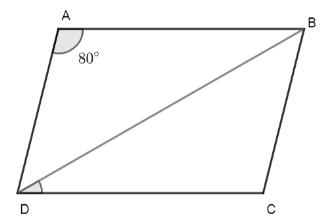
In the given figure, $ABCD$ is a Rhombus. If $\angle A = {80^ \circ }$, then find $\angle CDB$.


Answer
569.1k+ views
Hint: First use the property of transversal line for interior angles to get the relation between the angle A and D. Then use the property of Rhombus that its diagonals bisect the angles to get the desired result.
Complete step-by-step answer:
We have given in the problem that $ABCD$ is a Rhombus and the measure of the given angle is $\angle A = {80^ \circ }$.
So, we can say that $AB||CD$ and all the sides are equal in length using the property of Rhombus.
As we have given that $AB||CD$, then the line $AD$ is the transversal line through these lines.
Using the property of transversal line, that the pair of interior angles on the same side of the transversal line is supplementary. So, we have
$\angle A + \angle D = {180^ \circ }$
$\Rightarrow$$\angle D = {180^ \circ } - \angle A$
Substitute the value of the angle $\angle A = 80^\circ $ into the equation.
$\Rightarrow$$\angle D = {180^ \circ } - {80^ \circ }$
$\Rightarrow$$\angle D = {100^ \circ }$
We know that, $\angle D$ can be express as:
$\Rightarrow$$\angle ADB + \angle BDC = \angle D$
As we know, that the diagonals of the Rhombus bisect the angles, so we can conclude that $BD$ dissect the angle $\angle D$, so we have$\angle ADB = \angle BDC$. Then,
$\Rightarrow$$2\angle BDC = {100^ \circ }$
$\Rightarrow$$\angle BDC = \dfrac{{{{100}^ \circ }}}{2}$
$\Rightarrow$$\angle BDC = {50^ \circ }$
So, the required measure of the angle,$\angle BDC = {50^ \circ }$.
Note: Alternative method:
We know that $\angle A = \angle C$ and $\angle B = \angle D$ (opposite angle of the Rhombus are equal)
We know that the sum of all the interior angles of the Rhombus is $360^\circ $. So, we have $\angle A + \angle B + \angle C + \angle D = 360$
Substitute $\angle A = \angle C$ and $\angle B = \angle D$ into the equation:
$\Rightarrow$$2\angle A + 2\angle D = 360$
$ \Rightarrow \angle A + \angle D = 180$
$\Rightarrow$$\angle D = {180^ \circ } - \angle A$
Now, we substitute the given angle,$\angle A = {80^ \circ }$into the equation:
$\Rightarrow$$\angle D = {180^ \circ } - {80^ \circ }$
$\Rightarrow$$\angle D = {100^ \circ }$
As we know, that the diagonals of the Rhombus bisect the angles, so we can conclude that $BD$ dissect the angle $\angle D$, so we have $\angle ADB = \angle BDC$. Then,
$\Rightarrow$$2\angle BDC = {100^ \circ }$
$\Rightarrow$$\angle BDC = \dfrac{{{{100}^ \circ }}}{2}$
$\Rightarrow$$\angle BDC = {50^ \circ }$
So, the required measure of the angle,$\angle BDC = {50^ \circ }$.
Complete step-by-step answer:
We have given in the problem that $ABCD$ is a Rhombus and the measure of the given angle is $\angle A = {80^ \circ }$.
So, we can say that $AB||CD$ and all the sides are equal in length using the property of Rhombus.
As we have given that $AB||CD$, then the line $AD$ is the transversal line through these lines.
Using the property of transversal line, that the pair of interior angles on the same side of the transversal line is supplementary. So, we have
$\angle A + \angle D = {180^ \circ }$
$\Rightarrow$$\angle D = {180^ \circ } - \angle A$
Substitute the value of the angle $\angle A = 80^\circ $ into the equation.
$\Rightarrow$$\angle D = {180^ \circ } - {80^ \circ }$
$\Rightarrow$$\angle D = {100^ \circ }$
We know that, $\angle D$ can be express as:
$\Rightarrow$$\angle ADB + \angle BDC = \angle D$
As we know, that the diagonals of the Rhombus bisect the angles, so we can conclude that $BD$ dissect the angle $\angle D$, so we have$\angle ADB = \angle BDC$. Then,
$\Rightarrow$$2\angle BDC = {100^ \circ }$
$\Rightarrow$$\angle BDC = \dfrac{{{{100}^ \circ }}}{2}$
$\Rightarrow$$\angle BDC = {50^ \circ }$
So, the required measure of the angle,$\angle BDC = {50^ \circ }$.
Note: Alternative method:
We know that $\angle A = \angle C$ and $\angle B = \angle D$ (opposite angle of the Rhombus are equal)
We know that the sum of all the interior angles of the Rhombus is $360^\circ $. So, we have $\angle A + \angle B + \angle C + \angle D = 360$
Substitute $\angle A = \angle C$ and $\angle B = \angle D$ into the equation:
$\Rightarrow$$2\angle A + 2\angle D = 360$
$ \Rightarrow \angle A + \angle D = 180$
$\Rightarrow$$\angle D = {180^ \circ } - \angle A$
Now, we substitute the given angle,$\angle A = {80^ \circ }$into the equation:
$\Rightarrow$$\angle D = {180^ \circ } - {80^ \circ }$
$\Rightarrow$$\angle D = {100^ \circ }$
As we know, that the diagonals of the Rhombus bisect the angles, so we can conclude that $BD$ dissect the angle $\angle D$, so we have $\angle ADB = \angle BDC$. Then,
$\Rightarrow$$2\angle BDC = {100^ \circ }$
$\Rightarrow$$\angle BDC = \dfrac{{{{100}^ \circ }}}{2}$
$\Rightarrow$$\angle BDC = {50^ \circ }$
So, the required measure of the angle,$\angle BDC = {50^ \circ }$.
Recently Updated Pages
Master Class 9 Social Science: Engaging Questions & Answers for Success

Master Class 9 Science: Engaging Questions & Answers for Success

Master Class 9 English: Engaging Questions & Answers for Success

Master Class 9 Maths: Engaging Questions & Answers for Success

Master Class 9 General Knowledge: Engaging Questions & Answers for Success

Class 9 Question and Answer - Your Ultimate Solutions Guide

Trending doubts
Which places in India experience sunrise first and class 9 social science CBSE

Fill the blanks with the suitable prepositions 1 The class 9 english CBSE

Write the 6 fundamental rights of India and explain in detail

Difference Between Plant Cell and Animal Cell

What is pollution? How many types of pollution? Define it

What is the Full Form of ISI and RAW




